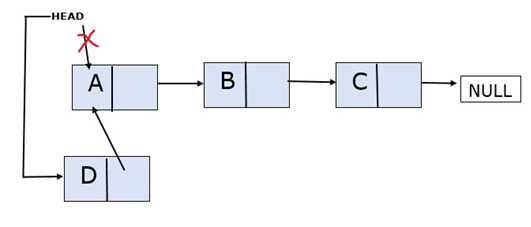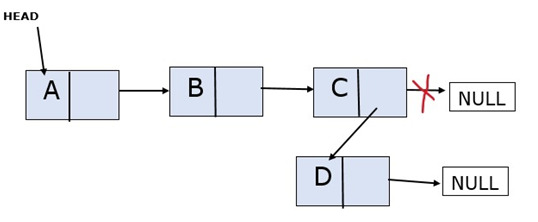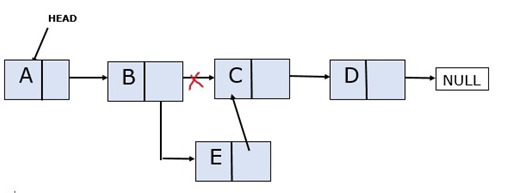Python 将元素添加到链表
什么是链表
当数据不存储在连续的内存位置时,搜索所有内存位置以获取所需数据需要很长时间。为了防止这种情况,我们使用链表。
在Python中,链表是一种按顺序存储项的数据结构。它由节点组成,每个节点包含项和列表中下一个节点的引用。第一个节点称为头节点,而最后一个节点被称为尾节点。
链表用于高效的插入和删除操作,因为新的项可以从列表中的任何位置添加或删除,而无需移动其他所有元素。此外,它们占用的内存空间比数组少,因为只需要存储引用而不是每个元素的副本。
链表由节点组成。每个节点包含:
- 数据
-
指向下一个节点的链接(通常是一个指针)
头节点将包含指向第一个节点的链接。最后一个节点将指向NULL。将元素添加到链表中有3种情况:可以在开头、结尾或中间(除了开头和结尾之外的任何位置)添加元素。
在开头添加元素
新节点添加在链表头之前。新添加的节点将成为链表的头。
考虑一个带有3个节点A、B和C的链表。要在开头添加新节点D。

步骤
步骤1 − 首先,创建一个新节点,将其分配给链表的开头,并分配数据。
步骤2 − 现在,使新节点指向头节点。
步骤3 − 使头节点指向新创建节点的地址。
函数实现
def insert_at_the_beginning(self, newVal):
newNode = Node(newVal) #creating the new node
newNode.next = self.head #pointing the new node to the previous first node
self.head = newNode #Making the head point to the newly added node
在末尾添加元素
新节点被添加到最后一个节点之后,并且新节点指向NULL。考虑有3个节点A,B和C的链表。新节点D将被添加到末尾。

步骤
步骤1 - 创建一个新的节点,将其添加到链表的开头,并分配数据并使其指向NULL。
步骤2 - 遍历到链表的末尾(当你遇到NULL时链表结束)
步骤3 - 使最后一个节点指向新创建的节点
函数实现
def insert_at_the_end(self,newVal):
newNode=Node(newVal)
temp=self.head
while(temp.next):
temp=temp.next
temp.next=newNode
在中间添加元素
给定要插入新节点的位置和数据。我们需要在给定位置插入新节点。
考虑具有4个节点A、B、C和D的链表。新节点E必须插入在位置3(即在节点B之后插入)。

步骤
步骤1 - 创建要添加到链表中间的新节点并分配数据。
步骤2 - 遍历链表,直到新节点的位置之前。
步骤3 - 假设要在位置“x”插入新节点。
-
遍历直到 x-1。
-
将新节点指向 (x-1.next)。
-
将 x-1 指向新节点。
函数实现
def insert_in_middle(self,newVal,pos):
newNode=Node(newVal)
temp=self.head
for i in range(2,pos):
if temp.next!=None:
temp=temp.next
newNode.next=temp.next
temp.next=newNode
Python 代码
class Node:
def __init__(self, val):
self.val = val
self.next = None
class LinkedList:
def __init__(self):
self.head = None
def insert_at_the_beginning(self, newVal):
newNode = Node(newVal) #creating the new node
newNode.next = self.head #pointing the new node to the previous first node
self.head = newNode #Making the head point to the newly added node
def insert_at_the_end(self,newVal):
newNode=Node(newVal)
temp=self.head
while(temp.next):
temp=temp.next
temp.next=newNode
def insert_in_middle(self,newVal,pos):
newNode=Node(newVal)
temp=self.head
for i in range(2,pos): #for traversing to the position where you want to insert the new node
if temp.next!=None:
temp=temp.next
newNode.next=temp.next
temp.next=newNode
def Print_the_LL(self):
temp = self.head
if(temp != None):
print("The linked list elements are:", end=" ")
while (temp != None):
print(temp.val, end=" ")
temp = temp.next
else:
print("The list is empty.")
newList = LinkedList()
print("\nEnter the number of elements you want to add into the linked list :")
n=int(input())
for i in range(n):
print("Chose from the following: 1.BEGINNING 2.END 3.MIDDLE")
a=int(input())
if(a==1):
print("Enter the data : ")
data=int(input())
newList.insert_at_the_beginning(data)
elif(a==2):
print("Enter the data : ")
data=int(input())
newList.insert_at_the_end(data)
else:
print("Enter the position: ")
pos=int(input())
print("Enter the data : ")
data=int(input())
newList.insert_in_middle(data,pos)
newList.Print_the_LL()
输出
Enter the number of elements you want to add into the linked list :
3
Chose from the following: 1.BEGINNING 2.END 3.MIDDLE
1
Enter the data :
112
Chose from the following: 1.BEGINNING 2.END 3.MIDDLE
2
Enter the data :
145
Chose from the following: 1.BEGINNING 2.END 3.MIDDLE
3
Enter the position:
2
Enter the data :
223
The linked list elements are: 112 223 145
 极客笔记
极客笔记